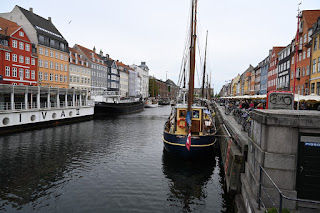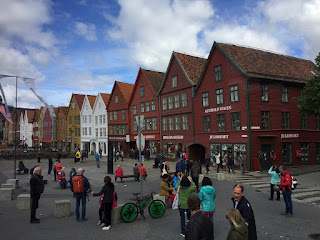The second half of our cruise started on May 25 with everyone else joining us onboard. On May 26, we took another Bergen shore excursion to Lyosen Island and Fantoft Stave Church.
Lyosen Island was the summer villa of Ole Bull, Norway's violinist born in 1810. The villa was completed in 1873 and is now a museum.
Lyosen Island was the summer villa of Ole Bull, Norway's violinist born in 1810. The villa was completed in 1873 and is now a museum.
Stave Church in Bergen burned down in 1992 and then was rebuilt in 1997. The inside looks like an upside down ship at the top of the church.
Day 3 we spent in Eidfjord, Norway. We took an excursion up to the Norsk Natursenter in Hardanger National Park. This is Europes largest mountain plateau, the Gateway to Hardangervidda
 |
| Goats mowing the roof of Visitor Center |
 |
| World's largest Pelton Runner used in HydropowerPlant |
That evening the ship brought on Pianist, Naomi Edemariam for the evening entertainment.
Day 4 we were in Stavanger, Norway, which is the oil capital of Norway. We took a walk of the old town/Gamie Stavanger, the new city area and toured the Norwegian Petroleum Museum. The city was honored in 2008 as the European Capital of Culture and is the 2nd most rainy city. Stavanger has the highest concentration of wooden buildings that date from the 17th - 20th century, with approx 250 being protected.
Day 5 we were in Alborg, Denmark. We visited the Voergaard Manor House. This house was built in the mid-1500s, but due to insurance reasons, we could not take photos inside. There was quite a collection of furniture, accessories and they have one of the finest private art collections in the country, that all primarily came from France. The house has a dungeon that is now being used as a wine cellar, but it was previously used to house prisoners. We also tasted the Pean Wine and actually bought some for our wine steward who shared with the sommelier on the ship.

Visited the Voer Kirke (church) and also a typical Denmark cemetery on the church's grounds. People can choose to pay .9 income tax per year to help the church upkeep the graves.

 |
| Dungeon/Wine Cellar |
Visited the Voer Kirke (church) and also a typical Denmark cemetery on the church's grounds. People can choose to pay .9 income tax per year to help the church upkeep the graves.
On Day 6 we were in Copenhagen, Denmark. While there we took two excursions, one called Copenhagen by Foot and another excursion was a Jazz Cruise on the canals.
We saw the Little Mermaid statute and the angel statute that honors those lives lost in World War I.
We saw the Little Mermaid statute and the angel statute that honors those lives lost in World War I.
We then walked through the Day Military Citadel built in 1660. The memorial is to the lost military - One Time, One Place, One Human Being.
 |
| Alban Church |
We then walked through Amalienborg Palace, winter residence of Denmark's royalty.
 |
| 500 year old buildings along canal |
 |
| Jazz cruise |
We then toured Berlin, Gernany on Day 7, docking in Warnemunde and taking a 2 1/2 hour train ride into Berlin. We took the tour through Historic Berlin, learning that 70% of the buildings in Berlin were bombed in the war. We also enjoyed a great German lunch.
 |
| Reichstag with glass cupola |
 |
| Berlin Cathedral |
 |
| St Nicholas Quarter |
 |
| St George Statute |
 |
| Neue Wache memorial - victims of war |
 |
| Brandenburg Gate |
 |
| Checkpoint Charlie at Allied Museum |
 |
| Holocaust Memorial |
 |
| Berlin Wall |
Day 8 we were in Poland and we toured the Stutthof Concentration Camp and then later had a polish dinner and toured the old part of Gdansk.
Stutthof Concentration Camp was the first camp outside of Germany, started in World War II and ended in 1989. There have been 480,000 pairs of shoes found in this camp and others in the area so far, as they are still finding shoes. The military would recycle the leather and then bury the shoes,
In the German nazi camps like this one, they would hold jews, and many other nationalities as prisoners. The camp became a museum in 1968. There were 15,000 camps and 10 million were killed. This camp was one of the largest as it had 3 factories attached to the prison.
Sites that we saw in Gdansk:
Westerplatte Museum created in 2015 to honor the Polish soldiers, seen from the port.
Sites that we saw in Gdansk:
Westerplatte Museum created in 2015 to honor the Polish soldiers, seen from the port.
Dinner with Captain Lars Kjeldsen, General Manager, Norbert Tesar, and cruise director along with two other couples that stayed on the ship for the full four weeks. There was a total of four couples that did the "butterfly" cruise.
We then visited Tallinn, Estonia, on Day 9, the country where Skype was created. We did a Panorama tour of the city.
First we visited the Upper Town:
First we visited the Upper Town:
 |
| St Mary's Lutheran Cathedral Of Virgin Mary 1200 |
 |
| 1700 Seat of Parliament |
 |
| Russian Orthodox Church |
 |
| Midieval Wall and Fortifications 1400s |
 |
| Herman Tower |
We then went to Maarjamae Palace in Pirita. This was used as a Russian Palace but is now a museum. It also has a Russian sculpture garden with rescued statutes.
Next stop was the Viimsi Open air museum that depicted Estonia sea living in the 19th & 20th century.
Last stop of the day was in the Rotterdam Quarter. This area had buildings with old and new artcitecture, such as the distillery pictured below.

Day 10 we were at sea, only day in this two week cruise, and then on Day 11 and 12 we were in St. Petersburg. We had to go through customs every time we got on and off the ship and we could not roam the city on our own, we had to be on a tour approved by the Russian Federation. So our tour was called the Ultimate St. Petersburg and was two full days, but absolutely excellent.
Catherine’s Summer Palace:
Most authentic Russian restaurant - Podvorie
Day 2:
Hermitage tour included many of the highlights but we did not have enough time to go through all 14 buildings, 3000 rooms. We visited the Galla Halls of the Winter Palace to include the Jordan staircase, the Throne Hall, the Glory of 1812 and the Pavilion Hall. We also saw Western European Art from the 13th to 19th centuries, such as Da Vinci, Raphael, Rembrandt, Velazquez, etc.
Peacock clock is the only large example of 18th century robotics which has survived unaltered into the 21st century. It was manufactured in 1777.
Largest vase in world - stone 19 tons of jasper
We then went to the Summer palace for Lunch which included having stroganoff for lunch.
After lunch we drove to Peterhof Palace, built by Peter the Great, and then came back to St Petersburg via the Gulf of Finland hydrofoil.
Hydofoil boat ride back to the ship.
After lunch we drove to Peterhof Palace, built by Peter the Great, and then came back to St Petersburg via the Gulf of Finland hydrofoil.
Hydofoil boat ride back to the ship.
We then visited Helsinki, Finland on day 13, doing a shore excursion called a "Glimpse of Helsinki", which that was exactly what it was. We only had two stops, so we were trying to take pictures from the bus. Helsinki is known as the "White City of the North".
We first drove to Sibelius Park and viewed the monument honoring Jean Sibelius, Finland's greatest composer. The monument is made from more than 600 stainless steel pipes set in a wave design.
We then drove through the city viewing the Olympic Stadium, which was built for the 1952 Summer Olympics.
We first drove to Sibelius Park and viewed the monument honoring Jean Sibelius, Finland's greatest composer. The monument is made from more than 600 stainless steel pipes set in a wave design.
We then drove through the city viewing the Olympic Stadium, which was built for the 1952 Summer Olympics.
We drove by the ice breaker fleet and then had free time at Senate Square in the heart of old city and location where the Helinski Cathedral is located.
On to our last stop on Day 14 where we did a tour of the Vasa Museum and saw Stockholm, Sweeden by boat. Stockholm is made up of 14 islands with 57 bridges. It is also the location of the Nobel Peace museum, where winners are announced on Alfred Nobel's death anniversary.
The story of the Vasa Ship is quite interesting. The Vasa was a 17th centrury Swedish warship that was built between 1625 - 1628. It sank in Swedish Harbor in 1628. It was raised out of the water 300 years later and is 90% plus original parts in a preserved status. The boat was built out of oak, was 69 meters long, and when it sank it had only got about 1400 yards into the Harbor with luckily only 150 people on board, but 30 people died.


 |
| Restaurant Villa Godthem |

 |
| Royal Palace |
On Day 15 we flew back to Portland where our motorhome was waiting for us.

































































































